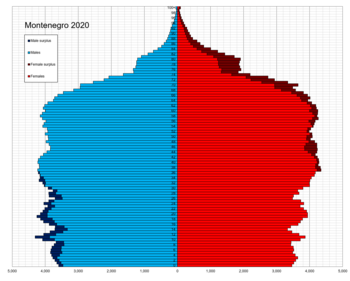This article includes information on the demographic history of Kosovo.

Pljevlja is a town and the center of Pljevlja Municipality located in Montenegro in the northern region. The town lies at an altitude of 770 m (2,530 ft). In the Middle Ages, Pljevlja had been a crossroad of the important commercial roads and cultural streams, with important roads connecting the littoral with the Balkan interior. In 2023, the municipality of Pljevlja had a population of 24,542, while the city itself had a population of 16,419. The municipality borders those of Žabljak, Bijelo Polje and Mojkovac in Montenegro, as well as Bosnia and Herzegovina to the west and Serbia to the northeast. With a total area of 1,346 km2 (520 sq mi), it is the third largest municipality in Montenegro.
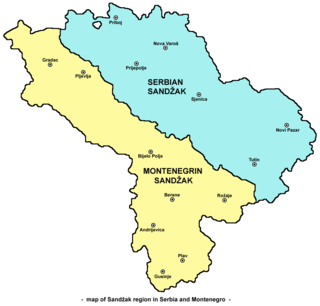
Sandžak is a historical geo-political region located in the southwestern part of Serbia and the eastern part of Montenegro. The name Sandžak derives from the Sanjak of Novi Pazar, a former Ottoman administrative district founded in 1865.

"Muslims" is a designation for the ethnoreligious group of Serbo-Croatian-speaking Muslims and people of Muslim heritage, inhabiting mostly the territory of the former Socialist Federal Republic of Yugoslavia. The term, adopted in the 1971 Constitution of Yugoslavia, groups together a number of distinct South Slavic communities of Islamic ethnocultural tradition. Prior to 1993, a vast majority of present-day Bosniaks self-identified as ethnic Muslims, along with some smaller groups of different ethnicity, such as Gorani and Torbeši. This designation did not include Yugoslav non-Slavic Muslims, such as Turks, some Romani people and majority of Albanians.

Montenegrins are a South Slavic ethnic group that share a common ancestry, culture, history, and language, identified with the country of Montenegro.
The demographic history of Montenegro can be shown through census results and official documents which mention demographic composition.

Demographic features of the population of Serbia include vital statistics, ethnicity, religious affiliations, education level, health of the populace, and other aspects of the population.
This article presents the demographic history of Serbia through census results. See Demographics of Serbia for a more detailed overview of the current demographics from 2011 census.

Rožaje is a town in Montenegro in the northern region.

This article is about the Demographic history of Bosnia and Herzegovina, and deals with the country's documented demographics over time. For an overview of the various ethnic groups and their historical development, see Ethnic groups in Bosnia and Herzegovina.

The municipalities are the first level administrative subdivisions of Montenegro. The country is divided into 25 municipalities including the Old Royal Capital Cetinje and the Podgorica Capital City. Podgorica is divided into one subdivision called city municipality, forming the most basic level of local government.

Islam in Montenegro refers to adherents, communities and religious institutions of Islam in Montenegro. It is the second largest religion in the country, after Christianity. According to the 2011 census, Montenegro's 118,477 Muslims make up 20% of the total population. Montenegro's Muslims belong mostly to the Sunni branch. According to the estimate by the Pew Research Center, Muslims have a population of 130,000 (20.3%) as of 2020.
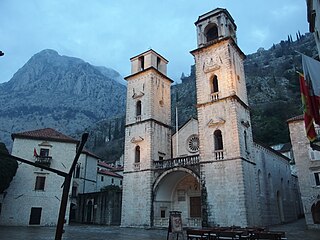
Eastern Orthodox Christianity is largest religion in Montenegro, but there are also sizeable numbers of adherents of both Catholic Christianity and Islam.

Croatia is a predominantly Christian country, with Islam being a minority faith. It is followed by 1.3% of the country's population according to the 2021 census. Islam was first introduced to Croatia by the Ottoman Empire during the Croatian–Ottoman Wars that lasted from the 15th to 16th century. During this period some parts of the Croatian Kingdom were occupied which resulted in some Croats converting to Islam, some after being taken prisoners of war, some through the devşirme system. Nonetheless, Austria strongly fought against the Turks during these few centuries which resulted in the fact that the westernmost border of the Ottoman Empire in Europe became entrenched on the Croatian soil. In 1519, Croatia was called the Antemurale Christianitatis by Pope Leo X in one letter, as well as Poland, Armenia or Albanians.

Bosniaks of Serbia are a recognized national minority in Serbia. According to the 2022 census, the population of ethnic Bosniaks in Serbia is 153,801, constituting 2.3% of the total population, which makes them the third-largest ethnic group in the country. The vast majority of them live in the southwestern part of the country that borders Montenegro and Kosovo, called Sandžak. Their cultural center is located in Novi Pazar.
This article presents the Demographic history of North Macedonia through census results since 1948.
This article presents the Demographic history of Slovenia, with census results where available. See Demographics of Slovenia for a more detailed overview of the current demographics from 2002 census.
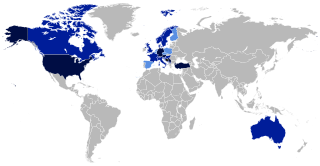
Bosnians are people native to the country of Bosnia and Herzegovina, especially the historical region of Bosnia. As a common demonym, the term Bosnians refers to all inhabitants/citizens of the country, regardless of any ethnic, cultural or religious affiliation. It can also be used as a designation for anyone who is descended from the region of Bosnia. Also, a Bosnian can be anyone who holds citizenship of the state of Bosnia and Herzegovina and thus is largely synonymous with the all-encompassing national demonym Bosnians and Herzegovinians.

The Kosovo Agency of Statistics monitors various demographic features of the population of Kosovo, such as population density, ethnicity, education level, health of the populace, economic status, religious affiliations and other aspects of the population. Censuses, normally conducted at ten-year intervals, record the demographic characteristics of the population. According to the first census conducted after the 2008 declaration of independence in 2011, the permanent population of Kosovo had reached 1,810,366.
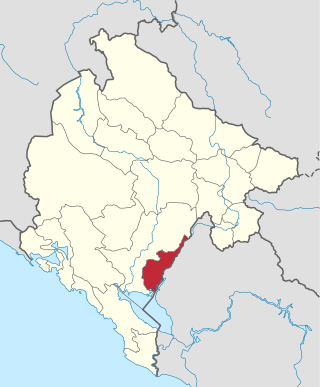
Tuzi Municipality is one of the 25 Municipalities of Montenegro. The municipal seat is the town of Tuzi. The municipality is located about 10 km south of the capital Podgorica and consists of more than 40 distinct settlements. The municipality roughly encompasses the Montenegrin part of Malesija region.
